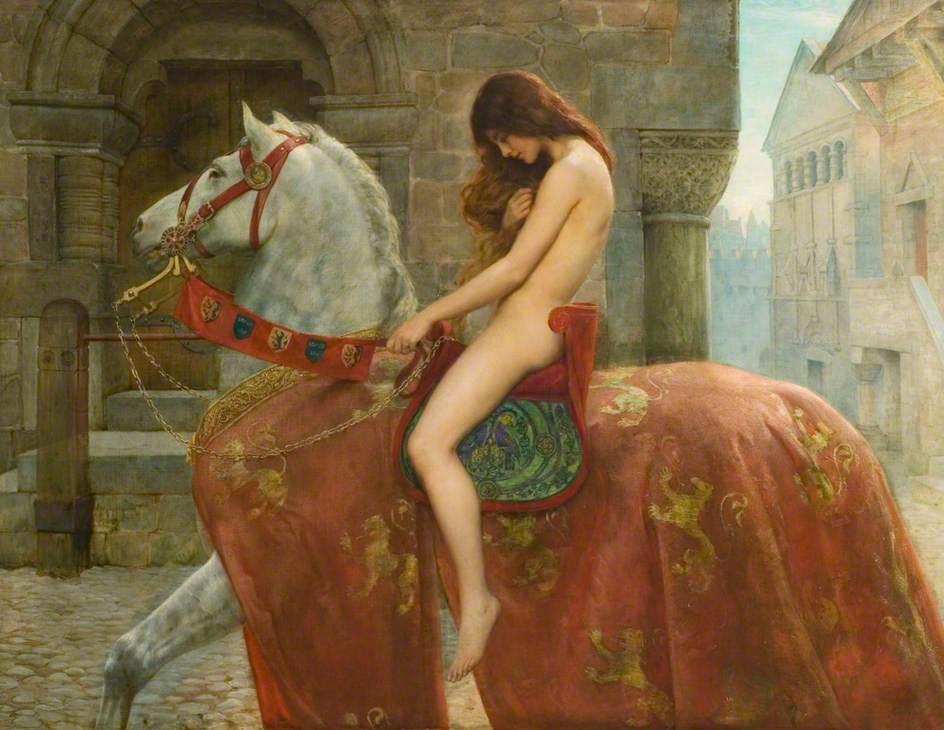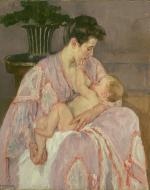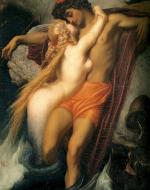Created by Kylie Bralczyk on Thu, 02/29/2024 - 22:32
Description:
Display Explanation-
In my Installation, the theme of acknowledging the complexities of women is the prominent theme. Therefore, the images in the installation will allow those viewing it within my museum to understand the theme better. The installation will be set in a 3-walled room, shaped almost like a tent, or a small pyramid. The three images will be placed on each wall, (1 painting per wall), and will be positioned in a way that makes the audience look up at the paintings to see them. The idea of the room being a 3 structure is to only allow space for one person in the room at a time, invoking silence in the room for each visitor. The wall with “Lady Godiva”, (behind the painting), the wall will be painted with orangey clouds. On the wall with “Young Woman Nursing her Child”, the wall will be painted with blueish clouds, and on the wall with “The Fisherman and the Syren”, there will be darkish clouds. The goal of each wall will be to emphasize the daylight cycle, which will reflect the changes, yet consistency in women’s experiences throughout life. As far as lighting within the installation, 3 lights will be placed along the floor, all allowing different lighting on each wall. As suggested in the clouds behind each painting, the lighting will follow the “daylight cycle” theme. On the “Lady Godiva” wall, the light on the floor will be directed towards the wall, with a warm light shining towards the painting. On the “Young Woman Nursing her Child” wall, the light shining towards the painting will be fluorescent white. And finally, “The Fisherman and the Syren” wall will be shined with a light that has purple hues. At the very top of the ceiling (or the point that all of the walls meet and connect), a dagger will be safely hung, placed directly in the center above all of the paintings. The floor will contrast the dagger and a synthetic grass patch will cover all of the floor. The synthetic grass will be soft, and allow visitors to lay on, to have another view of the paintings from a lower view, if they choose. Across all of the walls, there will be synthetic branches that travel around all of the paintings. The plaques that showcase each painting will be placed directly under each painting, offering a small description of each artist and their work (specifically the work within the installation).
Installation Note:
The 3 images within my installation (in order) are: “Lady Godiva” by John Collier, “Young Mother Nursing Her Child” by Mary Cassat, and “The Fisherman and the Syren” by Frederick Leighton. The common theme amongst all three of these images is the complexity of power among women. Although all of these images commonly emphasize the ideas of women's power, they also have contrasting ideas that can evoke different emotions from the audience. In “Lady Godiva”, a woman is pictured nude, sitting on the back of a white horse, with her hand placed on her chest. This image evokes the feeling of power in women’s experiences without the presence of others (such as a love interest). The components of this image that draw this conclusion are the woman's body posture, the horse itself, and the hand that is placed on her heart. First, The woman's posture, (although not perfectly straight), shows that she is in control of the horse, as she seems to be calm and aware of how to control it. Second, the horse seems to be comfortable with her presence, insinuating that the woman does have control over the horse, but also creates a sense of confidence between the two. Horses also represent strength, courage, and freedom which can also tie into the idea of “power” that the image provides. Finally, the woman’s hand is placed on her heart, and the audience can translate this as the woman is confident in her decisions, or simply confident in herself. This image alone shows the ability of women being able to hold power as an individual, which is an idea that is frequently dismissed in society., The second image, “Young Woman Nursing Her Child”, emphasizes the idea of power in motherhood. This is not to say that the mother is not the only one in power, but also the infant. In the image, a young mother is seen nursing her baby, dressing in a pink robe, while the baby softly caresses the mother's face. Both the mother and child represent power in this image since their relationship is not something that can be replicated. More specifically, the idea of motherhood (shared between the mother and the child) represents the idea of life which is something that centers around women's experiences. Finally, the third image, “The Fisherman and the Syren”, emphasizes the power of women in relation to sexuality. The image shows a woman (the syren), softly grasping a man’s neck in a watery environment. Although the woman is pictured lower than the man, a sense of power is evoked through both of their eye contact. The syren seems to have a grasp on the man's gaze, almost drawing him into her via eye contact. Typically, women are presented as being drawn into the man, yet this image provides the opposite approach, emphasizing the idea of power, once again. Despite the differences in all of these images provided, they all have one thing in common: which is the power of women’s experiences as a whole.
Copyright:
Associated Place(s)
Featured in Exhibit:
Artist:
- Multiple Artists




